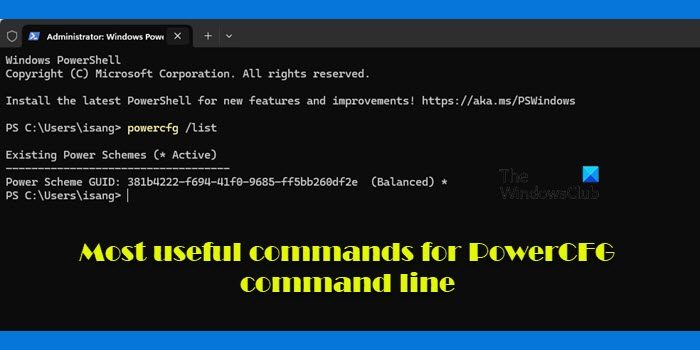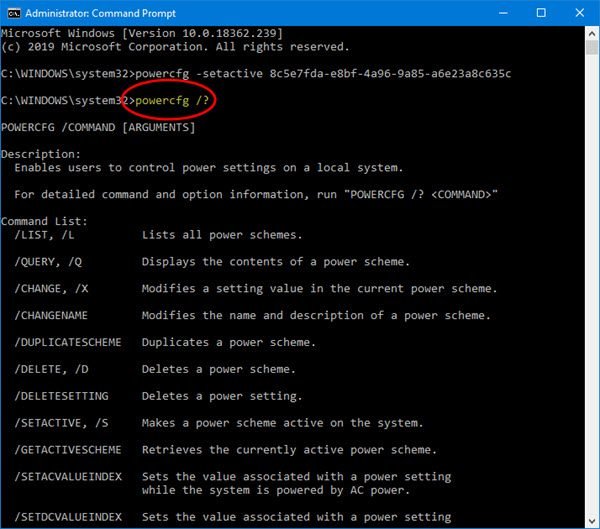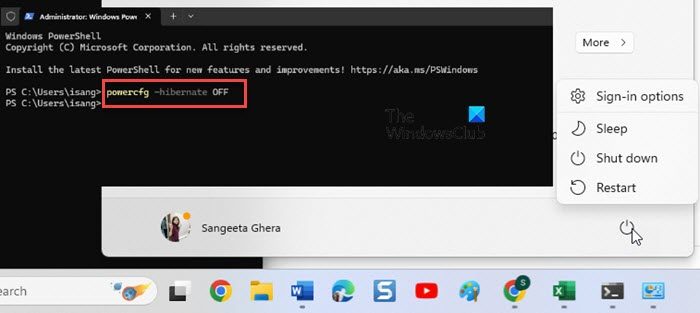Power Configuration or powercfg.exe is a command-line tool in Windows that allows you to configure power system settings on a Windows 11/10 PC. It is especially useful for laptops that run on battery and will enable you to configure hardware-specific configurations that are directly not available through the user interface. In this post, we are looking at the most useful commands for PowerCFG.

Useful PowerCFG commands
powercfg or powercfg.exe can be directly used from the Run prompt or using PowerShell or the Command Prompt. Here is the list of commands and options you can use to manage power settings and energy efficiency parameters in Windows:
- Change Power configuration for performance
- Tweak Basic Power Settings
- Enable/Disable Hibernation
- Ask for Password on Screen wakeup
- Change the power plan type
- Set hard disk timeout
- Change wireless adapter power-saving mode
- Change sleep timeout
- Set what happens when you close the laptop lid
- Change Processor Power State when on battery
- Set monitor timeout
- Change multimedia settings

Powercfg uses GUIDs, which is even more powerful. Use them only if you are a power user, and comfortable with the command line. Create a system restore point before you begin.
1] Set Power configuration to High Performance
powercfg -setactive 8c5e7fda-e8bf-4a96-9a85-a6e23a8c635c
2] Tweaks the basic power settings
powercfg -change -hibernate-timeout-ac x powercfg -change -hibernate-timeout-dc x
Where x is time in minutes. If you type powercfg -change -hibernate-timeout-ac 5, then the computer will hibernate in 5 minutes.
3] Turn off or disable hibernation

powercfg -hibernate OFF
4] Ask for Password on Screen wakeup
powercfg -setacvalueindex 8c5e7fda-e8bf-4a96-9a85-a6e23a8c635c fea3413e-7e05-4911-9a71-700331f1c294 0e796bdb-100d-47d6-a2d5-f7d2daa51f51 0
(0=false, 1=true)
5] Change power plan type
powercfg -setacvalueindex 8c5e7fda-e8bf-4a96-9a85-a6e23a8c635c fea3413e-7e05-4911-9a71-700331f1c294 245d8541-3943-4422-b025-13a784f679b7 1
(0=power saver, 1=high performance, 2=balanced)
6] Set hard disk timeout
powercfg -setdcvalueindex 8c5e7fda-e8bf-4a96-9a85-a6e23a8c635c 0012ee47-9041-4b5d-9b77-535fba8b1442 6738e2c4-e8a5-4a42-b16a-e040e769756e 0
7] Change wireless adapter power-saving mode
powercfg -setacvalueindex 8c5e7fda-e8bf-4a96-9a85-a6e23a8c635c 19cbb8fa-5279-450e-9fac-8a3d5fedd0c1 12bbebe6-58d6-4636-95bb-3217ef867c1a 0
(0=max perf, 1=low power saving, 2=med power saving, 3=max power saving)
8] Change sleep timeout
powercfg -setacvalueindex 8c5e7fda-e8bf-4a96-9a85-a6e23a8c635c 238c9fa8-0aad-41ed-83f4-97be242c8f20 29f6c1db-86da-48c5-9fdb-f2b67b1f44da x
Where x is time in minutes.
9] Set what happens when you close the laptop lid
powercfg -setacvalueindex 8c5e7fda-e8bf-4a96-9a85-a6e23a8c635c 4f971e89-eebd-4455-a8de-9e59040e7347 5ca83367-6e45-459f-a27b-476b1d01c936 0
(0=do nothing, 1=sleep, 2=hibernate, 3=shutdown)
10] Change Processor Power State when on battery
Use the following options to change the state.
- 0,1=power saver
- 2,3=balanced
- and 4,5=high performance.
Processor power state
powercfg -setacvalueindex 8c5e7fda-e8bf-4a96-9a85-a6e23a8c635c 54533251-82be-4824-96c1-47b60b740d00 68f262a7-f621-4069-b9a5-4874169be23c 4
Minimum processor state
powercfg -setacvalueindex 8c5e7fda-e8bf-4a96-9a85-a6e23a8c635c 54533251-82be-4824-96c1-47b60b740d00 893dee8e-2bef-41e0-89c6-b55d0929964c 100
Processor power perfstate settings
powercfg -setacvalueindex 8c5e7fda-e8bf-4a96-9a85-a6e23a8c635c 54533251-82be-4824-96c1-47b60b740d00 bbdc3814-18e9-4463-8a55-d197327c45c0 4
11] Set monitor timeout
powercfg -setacvalueindex 8c5e7fda-e8bf-4a96-9a85-a6e23a8c635c 7516b95f-f776-4464-8c53-06167f40cc99 3c0bc021-c8a8-4e07-a973-6b14cbcb2b7e x
Where x is time in minutes.
12] Change multimedia settings
powercfg -setacvalueindex 8c5e7fda-e8bf-4a96-9a85-a6e23a8c635c 9596fb26-9850-41fd-ac3e-f7c3c00afd4b 03680956-93bc-4294-bba6-4e0f09bb717f 2
(0=take no action, 1=prevent computer from sleeping, 2=enable away mode)
So if you are comfortable with using GUID, these commands will always be useful. We hope you found the commands easy to follow.
Source: docs.microsoft.com.
I hope you find this useful.
Read: How to Backup or Restore default Power Plans in Windows.
How to change power plan to high performance via cmd?
You may use the powercfg command-line tool to change the power plan to ‘High Performance’ via the Command Prompt (CMD) in Windows 11/10. Press Win + X and select Terminal (Admin) from the menu. Type powercfg -LIST in the PowerShell window and press Enter to see the list of all available power plans and their GUIDs. To set the ‘High Performance’ power plan as active, execute the following command: powercfg / -SETACTIVE <GUID>, while replacing <GUID> with the corresponding GUID for the High-Performance plan on your system.
What does powercfg CPL do?
Running the powercfg.cpl command opens the Power Options window (in the Control Panel) directly. This window is where you can view and modify power plans, adjust power settings, and configure how your computer manages power. You can run the powercfg.cpl command using the Run dialogue. Press Win + R to open the Run dialog. Type ‘powercfg.cpl‘ and press Enter. This action will open the Power Options Control Panel.
Read Next: Troubleshoot Power Plans in Windows with PowerCFG Tool.
Leave a Reply